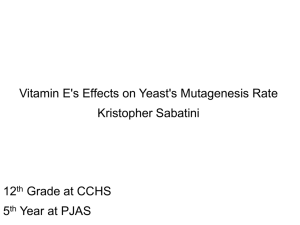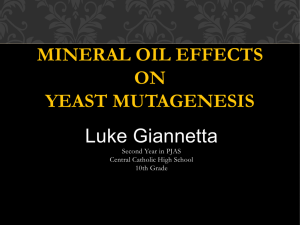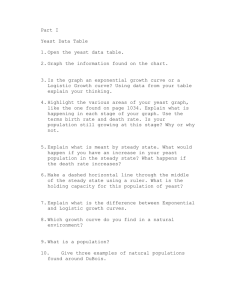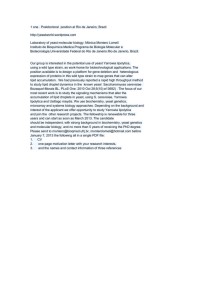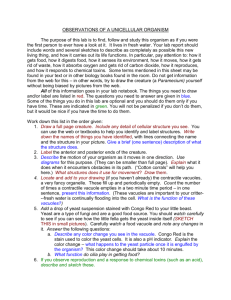Noah Stickel Selenium on Yeast Mutagenesis CCHS 2015 (2)
advertisement
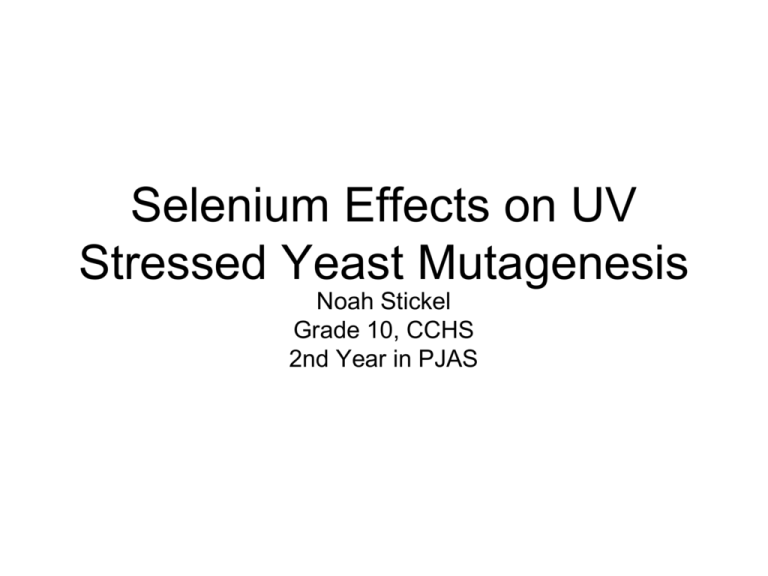
Selenium Effects on UV Stressed Yeast Mutagenesis Noah Stickel Grade 10, CCHS 2nd Year in PJAS Selenium • Atomic number 34, Atomic weight 78.96 • Taken commonly as a dietary supplement • Considered an essential trace element, but deficiencies are rare • 5 mg of pure selenium per kg of weight is a lethal dose • There are conflicting studies regarding its antimutagenic properties Question • Do Selenium supplements significantly affect the mutagenesis rate of yeast? Saccharomyces cerevisiae • Commonly known as yeast • Easy and safe to grow and culture, most commonly studied eukaryotic cell • The yeast in this experiment is unable to produce Lysine DNA and Mutations • Deoxyribonucleic Acid • Transcribed by RNA which is used by the Ribosome to ensemble proteins from amino acids • Eukaryotes have DNA inside their nuclei • Mutations are changes made to the cell's genome, and are mostly harmless • Can be caused by radiation, viruses, chemical mutagens, and random errors in DNA replication Lysine • Codons are AAA and AAG • There are defined minus lysine yeast mutants used in research • Lys 2 mutants are missing an enzyme function within the lysine biosynthesis pathway • Result: cells require lysine supplementation Ames Test • Developed to test the mutagenic and anti-mutagenic properties of various chemicals by Bruce Ames in the 1970's • Ames used a minus histidine mutant of salmonella, which could not produce histidine due to mutation • Exposure to suspected mutagen correlated which increased reversion (mutation) rate • Visible colonies appearing on complete -His media evidence of mutation through reversion. Modified Ames Test • The minus lysine yeast are a result of a single substitution in the lys-2 gene • A reversion at that point can result in a reversion back to wild type yeast (lys +) • The number of reverted colonies of yeast can be correlated with the rate of mutation • This test does not test general mutation, only mutation at a single point. The numbers are relative Ultraviolet Rays • Ultraviolet (UV) Rays have shorter wavelengths than visible light. They range from 400nm to 10nm • Given off by sun, but most are absorbed by the Ozone Layer • Problems in humans caused by over exposure: sunburn, sun poisoning, skin irritation, nausea, photo-aging, and possibly skin cancer • Shorter exposures can cause mutation instead of DNA damage Purpose • To determine the effects of a supposed antimutagen, Selenium, on the mutagenesis rate of ()Lys yeast, using a stressor, UV light. • To determine the effects of a known mutagen, UV light, on the mutagenesis and survivorship of wild type yeast and a (-) Lys strain Hypotheses • Null: Selenium will not have a significant effect on the mutagenesis rate of UV stressed yeast. • Alternative: UV light will significantly effect the mutagenesis rate of yeast Materials • (-) Lysine YEPD agar plates(1% yeast extract, 2% peptone, 2% dextrose, 1.5% agar) •Sterile dilution fluid [SDF] (10mM KH2PO4, 10mM K2HPO4, 1mM MgSO4, .1mM CaCl2, 100mM NaCl) •Klett spectrophotometer •Sterile pipette tips and Micropipettes •Vortex • Sidearm flask •Spreader bar •Ethanol • Micro burner • (-) Lysine Saccharomyces cerevisiae (CMU) • UV Hood • Rubber Gloves • Test tubes • Test Tube Rack • SDF Test Tubes • Giant Eagle Brand 200 mcg Selenium Tablets (Recommended dose of one tablet a day) other than Selenium the Tablets contain, Dicalcium Phosphate, Vegetable Cellulose, Brewer’s Yeast, Vegetable Stearic Acid, Vegetable Magnesium Stearate, and Silica Procedure 1. A strain of yeast (-) Lys phenotype was grown for 2 days in YEPD media, approximately 10^8 cells per ml 2. 4 days prior to experimentation the media was removed from the cell pellet and replaced with 3 mL of SDF. Prior to removal, a series of washes were conducted with SDF to remove any residual lysine nutrients 3. The pellet in SDF was resuspended, and stored in (-) Lys media for 2 days 4. A selenium stock solution of 1% (total mass) was made, along with a 0.1% stock for the 0.0001% concentration 5. The pellet in SDF was resuspended, and the following ingredients were pipetted into sterile 1.5 mL tubes Concentration Microbe Sterile Water Stock Solution Final Volume 0% 0.2 ml 0.8 ml - 1 ml 0.0001% 0.2 ml 0.799 0.001 1 ml 0.1% 0.2 ml 0.7 0.1 1 ml Procedure Continued 7. The cells were allowed to sit for 30 min. 8. 4 0.1 ml and 3 0.2 ml aliquots per experimental group were spread onto complete (-) Lys agar plates 9. 7 plates from each concentration were exposed to the following UV light times: 0s, 10s and 20s. 10. A UV survivorship curve of both lysine + and - was also plated and exposed, with no additional variable 11. The plates were allowed to incubate for 5 days at 32o C. 12. The colonies were counted and recorded. Each colony assumed to have arisen from 1 cell. Procedure for UV Exposure (-) Lys Yeast 1. 1. 0.1 mL of suspended Saccharomyces cerevisae cells were plated on each of 12 YEPD plates 2. The plates were exposed to UV light in groups of three at 0, 15, 30, and 45 seconds 3. The plates were incubated for three days at 32 degrees Celsius 4. The colonies were counted; each colony was assumed to have arisen from a single cell 0.1 mL of suspended (-) Lys cells were plated on each of 12 complete (-) Lys plates 2. The plates were exposed to UV light in groups of three at 0, 15, 30, and 45 seconds 3. The plates were incubated for three days at 32 degrees Celsius 4. Regular Yeast The colonies were counted; each colony was assumed to have arisen from a single cell 37.5 UV Exposure (-) Lys Yeast Results P-value: 0.000132 Colonies 30 22.5 15 7.5 0 0s 15s 30s Seconds 45s Dunnett's Tests T-Crit: 3.75 Test T-value Interpretation 0 sec vs 15 sec 4.8805 Significant 0 sec vs 30 sec 2.1603 Insignificant 0 sec vs 45 sec 0.7945 Insignificant UV Exposure (+) Lys Yeast Results 112.5 P-value: 0.000454 90 Colonies 67.5 45 22.5 0 0 15 Seconds 30 45 Dunnett's Tests T-Crit: 3.75 Test T-value Interpretation 0 sec vs 15 sec 1.87356 Insignificant 0 sec vs 30 sec 5.245857 Significant 0 sec vs 45 sec 6.958826 Significant Effects of Selenium on UV stressed Yeast's Mutagenesis Rate 40 Colonies Blue:0% Green: 0.001% Yellow: 0.1% 0.001% Pvalue: 0.076 0.1% P-value: 0.330 30 20 10 0 0s 10s UV Exposure Time 20s Conclusion • Null Hypothesis can be rejected, as statistical analysis did not show significant effect of selenium on UV stressed yeast's mutagenesis rate • Alternative Hypothesis can be accepted, as statistical analysis did show significant effect of UV on both yeast strains in some experimental groups • It appears that in the concentrations tested, Selenium is an ineffective anti-mutagen Limitations • The amount of cells per plate may have varied slightly • Plating was not perfectly synchronized • Slightly different positions in the UV hood • Inability to account for colony deaths due to exposure to UV light Extensions • Larger concentrations • Trypan Blue Assay to account for cell deaths • Use a different stressor • Use a different model Sources • http://www.ncbi.nlm.nih.gov/pubmed/17588734 • http://bioweb.uwlax.edu/bio203/s2007/nelson_andr/ • http://missionscience.nasa.gov/ems/10_ultravioletwa ves.html • http://users.rcn.com/jkimball.ma.ultranet/BiologyPag es/A/AmesTest.html ANOVA Example


